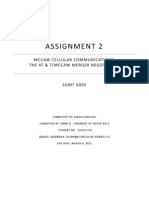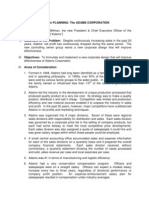Professional Documents
Culture Documents
Calling For Collaboration: Bringing Your Business A-Game
Uploaded by
fleish10 ratings0% found this document useful (0 votes)
113 views0 pagesMelissa's House founder, Elaine Goldberg, and The Wellington Head of School, Rob Brusk, are named to the 2013 Columbus Business First 20 to Know in Non-Profits list.
Original Title
Biz First 12-20-13: 20 To Know in Non-Profits
Copyright
© Attribution Non-Commercial (BY-NC)
Available Formats
PDF, TXT or read online from Scribd
Share this document
Did you find this document useful?
Is this content inappropriate?
Report this DocumentMelissa's House founder, Elaine Goldberg, and The Wellington Head of School, Rob Brusk, are named to the 2013 Columbus Business First 20 to Know in Non-Profits list.
Copyright:
Attribution Non-Commercial (BY-NC)
Available Formats
Download as PDF, TXT or read online from Scribd
0 ratings0% found this document useful (0 votes)
113 views0 pagesCalling For Collaboration: Bringing Your Business A-Game
Uploaded by
fleish1Melissa's House founder, Elaine Goldberg, and The Wellington Head of School, Rob Brusk, are named to the 2013 Columbus Business First 20 to Know in Non-Profits list.
Copyright:
Attribution Non-Commercial (BY-NC)
Available Formats
Download as PDF, TXT or read online from Scribd
You are on page 1of 0
DECEMBER 20, 2013 21
Whats the most exciting thing happening
today in nonprofits? I am seeing more for-
profit executives in the later parts of their
careers (50 years old-plus) making the switch
to the not-for-profit industry and wanting to
use their talents and experience to make a
diference in peoples lives.
Whats your biggest concern about the
profession? Too many people believe
that, as long as you have strong passion for
the mission of your organization, thats all
you need to be successful in the nonprofit
industry. Along with that, some people
surmise an individual is working in the
nonprofit industry because they werent
successful in the for-profit sector. Neither
of these could be further from the truth. A
not-for-profit career is just as competitive as
a for-profit career, and with all the seasoned
for-profit executives switching into the not-
for-profit industry, you need to bring your
A game to be a leader in the not-for-profit
sector today.
What would you change about nonprofits
in the U.S.? At the Furniture Bank, we believe
strongly that we should use fee for service
and social enterprise concepts to cover
our administrative and overhead expenses,
so that 100 percent of all donor dollars goes
directly toward making an impact in the lives
of the families we serve.
PEOPLE TO KNOW
Whats the most exciting thing
happening today in nonprofits? Innovative
organizations that challenge the traditional
nonprofit business model by seeking new
and creative ways to generate earned income
provide an exciting window on the future. It is
energizing to watch nonprofit leaders develop
social enterprises and test new ways to fund
programs and services.
Whats your biggest concern about the
profession? I worry about the human
resources that staf nonprofits. The traditional
business model where the organization must
raise all of its annual funding frequently leads
to staf burnout. With such significant staf
turnover in the development field, missed
opportunities for grants and setbacks in
advancing organizational mission occur too
often.
What would you change about nonprofits
in the U.S.? The nonprofit sector would be
stronger if there were more collaborations
and partnerships. In Columbus there are
impressive examples of mergers, shared
services and true collaborations that have
resulted in strong and efective programs and
services. Innovative ways of working together
will further strengthen our community.
LISA SCHWEITZER COURTICE
Executive vice president | Columbus Foundation
Calling for collaboration
JANET ADAMS
Lisa Schweitzer Courtice: Turnover in development oces leads to setbacks.
FILE PHOTO
Jim Stein: Fee for service and social
enterprise models work for nonprots.
TRACY ROSS
Executive director | American
Diabetes Association
Why did you get into this
profession? Immediately out of
college I had an opportunity to
join a small nonprofit providing
services to women in crisis and
was bitten by the nonprofit bug.
Working at a nonprofit is truly
an extension of my personal
mission.
Whats the most exciting thing
happening today in nonprofits?
Social media and tools such
as Catapult, Gofundme, etc.
are making it very easy to gain
financial support from donors.
Whats your biggest concern
about the profession? Changes
in charitable tax deduction rules
as well as our limited recognition
of demographic shifts. The
most successful nonprofits of
the future will be those that
know how to attract donors and
leaders who reflect our countrys
diversity.
What would you change about
nonprofits in the U.S.? The
way we often view ourselves.
The nonprofit sector is the very
essence on which our country
was founded.
ROBERT BRISK
Head of school |
The Wellington School
Why did you get into this
profession? I received an
extraordinary and life-changing
education. I can still remember
overhearing two of my Latin
teachers arguing passionately
about a Horace poem. Observing
educators deeply committed
to the life of the mind and
collaborating as colleagues made
me want to help others discover
the very same joy in similar
moments.
Whats your biggest concern
about the profession? My
greatest concern in education
is legislative intrusion.
Unfortunately for students,
regulators have become
entrenched in high-stakes
testing, which tends to create
a one-size-fits-all mentality in
schools. Nonprofit, independent
schools such as Wellington often
are the targets of such legislative
intrusion. Rather, education
should be about creating
opportunities for students to find
passionate areas of interest.
ELAINE GOLDBERG
Founder | Melissas House
Why did you get into this
profession? Creating a
supportive, permanent, safe
haven for adults living with
mental illness is a personal
mission for me. Our daughter
Melissa struggled with mental
illness most of her adult life.
Despite my familys tireless
eforts, we could not find an
environment for Melissa that was
safe, comfortable, welcoming
and supportive. Melissas House
will be that place.
Whats your biggest concern
about the profession? There are
so many worthwhile nonprofits
out there that all deserve
attention and funding. But that
means that sometimes we are
in competition for donations,
time and support. There is no
assurance a nonprofit will survive
and grow regardless of how
important the cause is.
What would you change about
nonprofits in the U.S.? The legal
requirements that nonprofits
must follow can be complicated.
There are regulations at the
federal, state and even local
level and if you are a layman, you
almost always will need outside
assistance to navigate the
system, which is expensive. At
times all the red tape gets in the
way of momentum and progress.
JIM STEIN
President | Furniture Bank of Central Ohio
Bringing your business A-game
COURTESY MELISSAS HOUSE
A
m
e
r
i
c
a
n
C
i
t
y
B
u
s
i
n
e
s
s
J
o
u
r
n
a
l
s
-
N
o
t
f
o
r
c
o
m
m
e
r
c
i
a
l
u
s
e
You might also like
- Eminent Domain Attorneys File Motion To Protect Ohio Landowners Likely Affected by NEXUS PipelineDocument2 pagesEminent Domain Attorneys File Motion To Protect Ohio Landowners Likely Affected by NEXUS Pipelinefleish1No ratings yet
- Norman Guitry Award PresentationDocument1 pageNorman Guitry Award Presentationfleish1No ratings yet
- Maximizing Property Protection: Property Owners Protecting Their Land From PipelineDocument1 pageMaximizing Property Protection: Property Owners Protecting Their Land From Pipelinefleish1No ratings yet
- Maximizing Property Protection: Property Owners Protecting Their Land From PipelineDocument1 pageMaximizing Property Protection: Property Owners Protecting Their Land From Pipelinefleish1No ratings yet
- The Subtle Art of Not Giving a F*ck: A Counterintuitive Approach to Living a Good LifeFrom EverandThe Subtle Art of Not Giving a F*ck: A Counterintuitive Approach to Living a Good LifeRating: 4 out of 5 stars4/5 (5783)
- The Yellow House: A Memoir (2019 National Book Award Winner)From EverandThe Yellow House: A Memoir (2019 National Book Award Winner)Rating: 4 out of 5 stars4/5 (98)
- Never Split the Difference: Negotiating As If Your Life Depended On ItFrom EverandNever Split the Difference: Negotiating As If Your Life Depended On ItRating: 4.5 out of 5 stars4.5/5 (838)
- Shoe Dog: A Memoir by the Creator of NikeFrom EverandShoe Dog: A Memoir by the Creator of NikeRating: 4.5 out of 5 stars4.5/5 (537)
- The Emperor of All Maladies: A Biography of CancerFrom EverandThe Emperor of All Maladies: A Biography of CancerRating: 4.5 out of 5 stars4.5/5 (271)
- Hidden Figures: The American Dream and the Untold Story of the Black Women Mathematicians Who Helped Win the Space RaceFrom EverandHidden Figures: The American Dream and the Untold Story of the Black Women Mathematicians Who Helped Win the Space RaceRating: 4 out of 5 stars4/5 (890)
- The Little Book of Hygge: Danish Secrets to Happy LivingFrom EverandThe Little Book of Hygge: Danish Secrets to Happy LivingRating: 3.5 out of 5 stars3.5/5 (399)
- Team of Rivals: The Political Genius of Abraham LincolnFrom EverandTeam of Rivals: The Political Genius of Abraham LincolnRating: 4.5 out of 5 stars4.5/5 (234)
- Grit: The Power of Passion and PerseveranceFrom EverandGrit: The Power of Passion and PerseveranceRating: 4 out of 5 stars4/5 (587)
- Devil in the Grove: Thurgood Marshall, the Groveland Boys, and the Dawn of a New AmericaFrom EverandDevil in the Grove: Thurgood Marshall, the Groveland Boys, and the Dawn of a New AmericaRating: 4.5 out of 5 stars4.5/5 (265)
- A Heartbreaking Work Of Staggering Genius: A Memoir Based on a True StoryFrom EverandA Heartbreaking Work Of Staggering Genius: A Memoir Based on a True StoryRating: 3.5 out of 5 stars3.5/5 (231)
- On Fire: The (Burning) Case for a Green New DealFrom EverandOn Fire: The (Burning) Case for a Green New DealRating: 4 out of 5 stars4/5 (72)
- Elon Musk: Tesla, SpaceX, and the Quest for a Fantastic FutureFrom EverandElon Musk: Tesla, SpaceX, and the Quest for a Fantastic FutureRating: 4.5 out of 5 stars4.5/5 (474)
- The Hard Thing About Hard Things: Building a Business When There Are No Easy AnswersFrom EverandThe Hard Thing About Hard Things: Building a Business When There Are No Easy AnswersRating: 4.5 out of 5 stars4.5/5 (344)
- The Unwinding: An Inner History of the New AmericaFrom EverandThe Unwinding: An Inner History of the New AmericaRating: 4 out of 5 stars4/5 (45)
- The World Is Flat 3.0: A Brief History of the Twenty-first CenturyFrom EverandThe World Is Flat 3.0: A Brief History of the Twenty-first CenturyRating: 3.5 out of 5 stars3.5/5 (2219)
- The Gifts of Imperfection: Let Go of Who You Think You're Supposed to Be and Embrace Who You AreFrom EverandThe Gifts of Imperfection: Let Go of Who You Think You're Supposed to Be and Embrace Who You AreRating: 4 out of 5 stars4/5 (1090)
- The Sympathizer: A Novel (Pulitzer Prize for Fiction)From EverandThe Sympathizer: A Novel (Pulitzer Prize for Fiction)Rating: 4.5 out of 5 stars4.5/5 (119)
- Her Body and Other Parties: StoriesFrom EverandHer Body and Other Parties: StoriesRating: 4 out of 5 stars4/5 (821)
- A Compendium and Comparison of 25 Project Evaluation Techniques. Part 2 Ratio, Payback, and Accounting MethodsDocument29 pagesA Compendium and Comparison of 25 Project Evaluation Techniques. Part 2 Ratio, Payback, and Accounting MethodsRama RenspandyNo ratings yet
- Amana Bank 5e8f0988752af PDFDocument1 pageAmana Bank 5e8f0988752af PDFKiyanga MbodoNo ratings yet
- HCM Signalized Intersection Capacity Analysis SummaryDocument1 pageHCM Signalized Intersection Capacity Analysis SummaryEduardo Talla NegreirosNo ratings yet
- DissolutionDocument3 pagesDissolutionDonna Mae HernandezNo ratings yet
- BSI Update Standards December 2013 UK enDocument52 pagesBSI Update Standards December 2013 UK enCarolSerban100% (2)
- AutoInvoice Execution ReportDocument6 pagesAutoInvoice Execution ReportabduskhanNo ratings yet
- Case Study 01 - Apple Value ChainDocument3 pagesCase Study 01 - Apple Value ChainArun AbNo ratings yet
- Competitive Industrial Performance Index - 2020Document2 pagesCompetitive Industrial Performance Index - 2020Hamit OzmanNo ratings yet
- CP IIDocument540 pagesCP IIMichael Tache VictorinoNo ratings yet
- Oracle ERP AGIS for Intercompany TransactionsDocument8 pagesOracle ERP AGIS for Intercompany TransactionsAmitNo ratings yet
- Half-Bridge Driver (S) : Features Product SummaryDocument9 pagesHalf-Bridge Driver (S) : Features Product SummaryMahmoued YasinNo ratings yet
- Chapter 2 Demand and Supply AnalysisDocument44 pagesChapter 2 Demand and Supply AnalysisNur AtikahNo ratings yet
- POS For Auction by Kamal AGDocument1 pagePOS For Auction by Kamal AGKamal AgNo ratings yet
- Audit PlanningDocument6 pagesAudit PlanningFrancis Martin90% (10)
- BabeDocument16 pagesBabeNathan FellixNo ratings yet
- F6uk 2011 Dec QDocument12 pagesF6uk 2011 Dec Qmosherif2011No ratings yet
- Projected Cash Flow StatementDocument6 pagesProjected Cash Flow StatementIqtadar AliNo ratings yet
- Capitol 10 CorectDocument50 pagesCapitol 10 CorectRatiu SilviuNo ratings yet
- Note On Ssi RegistrationDocument9 pagesNote On Ssi RegistrationJayanthi BalasubramaniamNo ratings yet
- Cadbury Schweppes: Capturing Confectionery (A)Document5 pagesCadbury Schweppes: Capturing Confectionery (A)Rubak Bhattacharyya100% (2)
- S. Anand and V.C SekharDocument8 pagesS. Anand and V.C Sekharshlokshah2006No ratings yet
- Books of 2021Document67 pagesBooks of 2021Joey De CelioNo ratings yet
- 1-4 Building Economics and SociologyDocument37 pages1-4 Building Economics and SociologySamreen Khan0% (1)
- Exam Blueprint: ConciseDocument5 pagesExam Blueprint: ConciseGlc PekanbaruNo ratings yet
- Equilibrium State: Chemistry Topic 7 - Equilibrium Key-Term Description/ Extra Info. DiagramDocument7 pagesEquilibrium State: Chemistry Topic 7 - Equilibrium Key-Term Description/ Extra Info. DiagramRudy YoishoNo ratings yet
- Make Buy Special Order TutorialDocument5 pagesMake Buy Special Order TutorialMickel Alexander100% (1)
- AT&T/McCaw Merger Valuation and Negotiation StrategyDocument9 pagesAT&T/McCaw Merger Valuation and Negotiation StrategySong LiNo ratings yet
- Adams CorporationDocument2 pagesAdams Corporationrocamorro67% (6)
- School uniforms vs casual clothes debateDocument2 pagesSchool uniforms vs casual clothes debatePham HienNo ratings yet
- Perform financial calculations efficientlyDocument20 pagesPerform financial calculations efficientlyrame100% (2)









































































